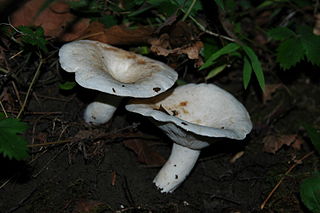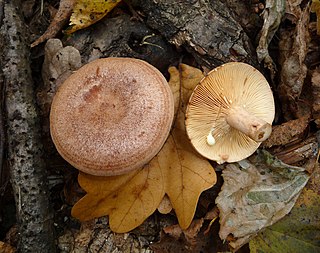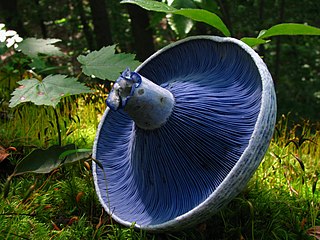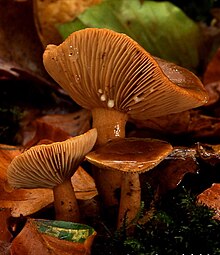
Lactarius deterrimus, also known as false saffron milkcap or orange milkcap, is a species of fungus in the family Russulaceae. The fungus produces medium-sized fruit bodies (mushrooms) with orangish caps up to 12 centimetres wide that develop green spots in old age or if injured. Its orange-coloured latex stains maroon within 30 minutes. Lactarius deterrimus is a mycorrhizal fungus that associates with Norway spruce and bearberry. The species is distributed in Europe, but has also found in parts of Asia. A visually similar species in the United States and Mexico is not closely related to the European species. Fruit bodies appear between late June and November, usually in spruce forests. Although the fungus is edible—like all Lactarius mushrooms from the section Deliciosi—its taste is often bitter, and it is not highly valued. The fruit bodies are used as source of food for the larvae of several insect species. Lactarius deterrimus can be distinguished from similar Lactarius species by difference in the mycorrhizal host or latex colour.

Lactifluus vellereus, commonly known as the fleecy milk-cap, is a quite large fungus in the genus Lactifluus. It is one of the two most common milk-caps found with beech trees, with the other being Lactarius subdulcis.

Lactarius torminosus, commonly known as the woolly milkcap or the bearded milkcap, is a large species of agaric fungus. A common and widely distributed species, it is found in North Africa, northern Asia, Europe, and North America. It was first described scientifically by Jacob Christian Schäffer in 1774 as an Agaricus, and later transferred to the genus Lactarius in 1821 by Samuel Frederick Gray. A variety, L. torminosus var. nordmanensis, is known from the United States, Canada, and Switzerland. L. torminosus officially became the type species of Lactarius in 2011 after molecular studies prompted the taxonomic reshuffling of species between several Russulaceae genera.
Cortinarius caperatus is an edible mushroom of the genus Cortinarius found in northern regions of Europe and North America. It was known as Rozites caperata for many years before genetic studies revealed that it belonged to the genus Cortinarius. The fruit bodies appear in autumn in coniferous and beech woods as well as heathlands in late summer and autumn. The ochre-coloured cap is up to 10 cm (4 in) across and has a fibrous surface. The clay-colored gills are attached to the stipe under the cap, and the stipe is whitish with a whitish ring. The Latin specific name, caperatus, means wrinkled, and refers to the distinctive texture of the cap. The flesh has a mild smell and flavor.

Lactarius pyrogalus, commonly known as the fire-milk lactarius, is a species of inedible mushroom in genus Lactarius. It is greyish and differentiated from other grey Lactarius by its widely spaced, yellow gills. It is found on the forest floor in mixed woodland, especially at the base of hazel trees.

Lactifluus piperatus, commonly known as the blancaccio, is a semi-edible basidiomycete fungus of the genus Lactifluus. Despite being edible, it is not recommended by some because of its poor taste, though can be used as seasoning when dried. The fruiting body is a creamy-white mushroom which is funnel-shaped when mature, with exceptionally crowded gills. It bleeds a whitish peppery-tasting milk when cut. Widely distributed across Europe and eastern North America, Lactifluus piperatus has been accidentally introduced to Australia. Mycorrhizal, it forms a symbiotic relationship with various species of deciduous tree, including beech, and hazel, and fruiting bodies are found on the forest floor in deciduous woodland.

Lactarius blennius is a medium-sized mushroom of the genus Lactarius found commonly in beech forests in Europe, where it is mycorrhizal, favouring the European beech. It was first described by Elias Magnus Fries. Though its colour and size vary, it is distinctive because it is slimy when wet and exudes copious amounts of milk. It has been the subject of some chemical research, and it can be used to produce pigments and blennins. Blennins, some of which have shown potential medical application, are derived from lactarane, a chemical so named because of their association with Lactarius. The edibility of L. blennius is uncertain, with different mycologists suggesting that it is edible, inedible or even poisonous.

Russula delica is a mushroom that goes by the common name of milk-white brittlegill, and is a member of the genus Russula, all of which are collectively known as brittlegills. It is mostly white, with ochraceous or brownish cap markings, and a short robust stem. It is edible, but poor in taste, and grows in coniferous, broadleaved, or mixed woods. It can be confused with other white Russula species and certain white Lactarius species.

Lactarius rufus is a common, medium-sized member of the mushroom genus Lactarius, whose many members are commonly known as milkcaps. Known by the common name of the rufous milkcap, or the red hot milk cap in North America. It is dark brick red in color, and grows with pine or birch trees.

Lactifluus volemus, formerly known as Lactarius volemus, and commonly known as the weeping milk cap or bradley, is a species of fungus in the family Russulaceae. It is widely distributed in the northern hemisphere, in temperate regions of Europe, North America and Asia as well as some subtropical and tropical regions of Central America and Asia. A mycorrhizal fungus, its fruit bodies grow on the ground at the base of various species of trees from summer to autumn, either individually or in groups. It is valued as an edible mushroom, and is sold in markets in Asia. Several other Lactifluus mushrooms resemble L. volemus, such as the closely related edible species L. corrugis, but these can be distinguished by differences in distribution, visible morphology, and microscopic characteristics. L. volemus produces a white spore print and has roughly spherical spores about 7–8 micrometres in diameter.

Lactarius glyciosmus, commonly known as the coconut scented milk cap, is a semi-edible mushroom in the genus Lactarius. Mycorrhizal, it can be found growing in soil at the base of birch trees in Europe. It is typically coloured a greyish lilac, with the sometimes hollow stem a little lighter coloured than the cap. It has crowded, decurrent gills, and smells strongly of coconuts.

Lactarius vietus is a species of fungus in the family Russulaceae, first described by Elias Magnus Fries. It produces moderately sized and brittle mushrooms, which grow on the forest floor or on rotting wood. The flattened-convex cap can vary in shape, sometimes forming the shape of a wide funnel. It is typically grey, but the colour varies. The species has crowded, light-coloured gills, which produce white milk. The spore print is typically whitish, but also varies considerably. The mushrooms typically have a strong, acrid taste and have been described as inedible, but other authors have described them as consumable after boiling. L. vietus feeds by forming an ectomycorrhizal relationship with surrounding trees, and it favours birch. It grows in autumn months and is fairly common in Europe, North America and eastern Asia.

Lactarius pallidus, the pale milkcap, is an edible mushroom of the genus Lactarius. It is pale in colour, and found on the floor in beech or birch woodland. It's smooth cap features a particularly thick layer of flesh and often has an incurved margin. Though generally considered edible, it is not recommended to be eaten raw. It is common in Europe, and less common in North America and Australasia.

Lactarius quietus is a mushroom of the genus Lactarius. It is easily identified by its oily scent and the concentric bands on its cap. It is brown, and is probably named after its matte, "quiet" surface and colouration. It is found exclusively under oak trees in Europe, where it grows solitarily or in scattered groups in autumn months. In North America, the variety L. quietus var. incanus is fairly common in the same habitat. The mushroom's edibility is disputed.

Ampulloclitocybe clavipes, commonly known as the club-foot or club-footed clitocybe, is a species of gilled mushroom from Europe and North America. The grey brown mushrooms have yellowish decurrent gills and a bulbous stalk, and are found in deciduous and conifer woodlands. Although considered edible, disulfiram-like reactions have been reported after consumption of alcohol after eating this mushroom.

Lactarius indigo, commonly known as the indigo milk cap, indigo milky, indigo lactarius, blue lactarius, or blue milk mushroom, is a species of agaric fungus in the family Russulaceae.

Lactarius alnicola, commonly known as the golden milkcap, is a species of fungus in the family Russulaceae. The fruit bodies produced by the fungus are characterized by a sticky, vanilla-colored cap up to 20 cm (7.9 in) wide with a mixture of yellow tones arranged in faint concentric bands. The stem is up to 5 cm (2.0 in) long and has yellow-brown spots. When it is cut or injured, the mushroom oozes a white latex, which has an intensely peppery taste. The acrid taste of the fruit bodies renders them unpalatable. The fungus is found in the western United States and Mexico, where it grows in mycorrhizal associations with various coniferous trees species, such as spruce, pine and fir, and deciduous species such as oak and alder. It has also been collected in India. Two varieties have been named: var. pitkinensis, known from Colorado, and var. pungens, from Michigan.

Lactarius affinis, commonly known as the kindred milk cap, is a species of milk-cap mushroom in the family Russulaceae. It is found northeastern North America, where it fruits in the summer and fall, and is common in the Great Lakes region. Its fruit bodies have medium to large, slimy dull yellow or brownish caps. Although not considered poisonous, it is unpalatable because of its highly acrid taste.

Lactarius fallax, commonly known as the velvety milk cap, is a species of fungus in the family Russulaceae. Found in both spruce and mixed conifer forests, it is a fairly common species in the Pacific Northwest region of North America, with a northerly range extending to Alaska. Its fruit bodies are medium-sized, with velvety, brown to blackish caps up to 3–9 cm (1.2–3.5 in) in diameter bearing a distinct pointed umbo. The caps are supported by velvety stems up to 6 cm (2.4 in) long and 1.5 cm (0.6 in) thick. The mushroom oozes a whitish latex when it is cut, and injured tissue eventually turns a dull reddish color. The eastern North American and European species Lactarius lignyotus is closely similar in appearance, but can be distinguished by its differing range.

Lactarius argillaceifolius is a species of fungus in the family Russulaceae. The mushrooms produced by the fungus have convex to flattened drab lilac-colored caps that are up to 18 cm (7.1 in) wide. The cream-colored gills are closely spaced together and extend slightly down the length of the stem, which is up to 9 cm (3.5 in) long by 3.5 cm (1.4 in) thick. The mushroom produces an off-white latex when injured that stains the mushroom tissue brownish.




















